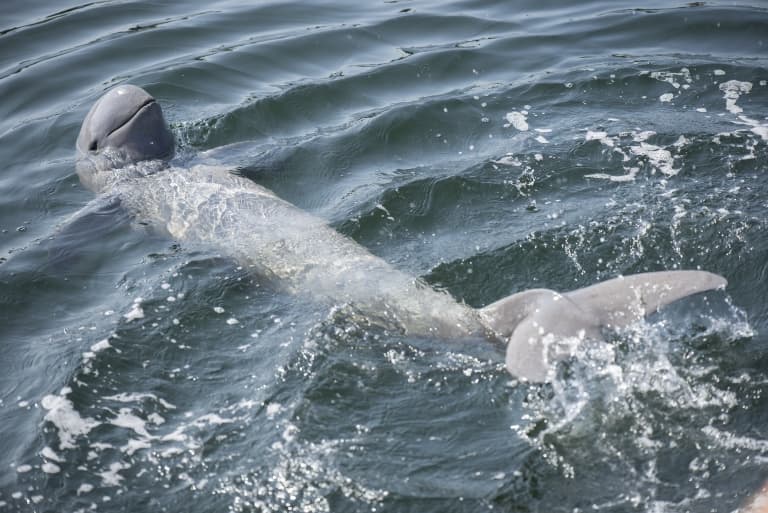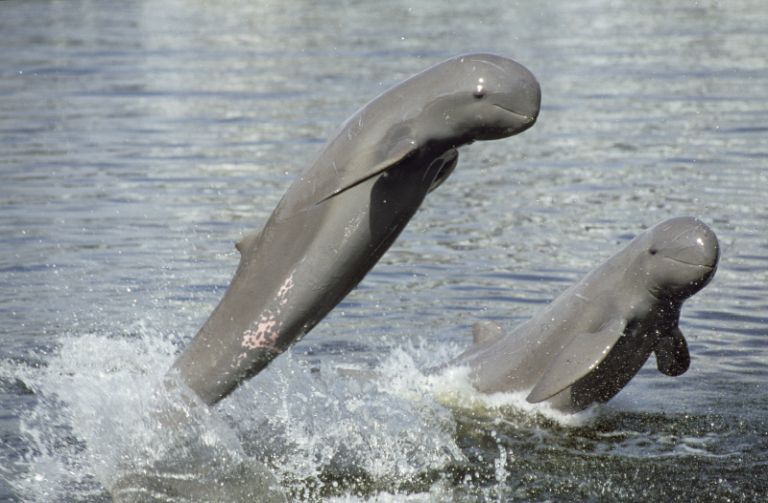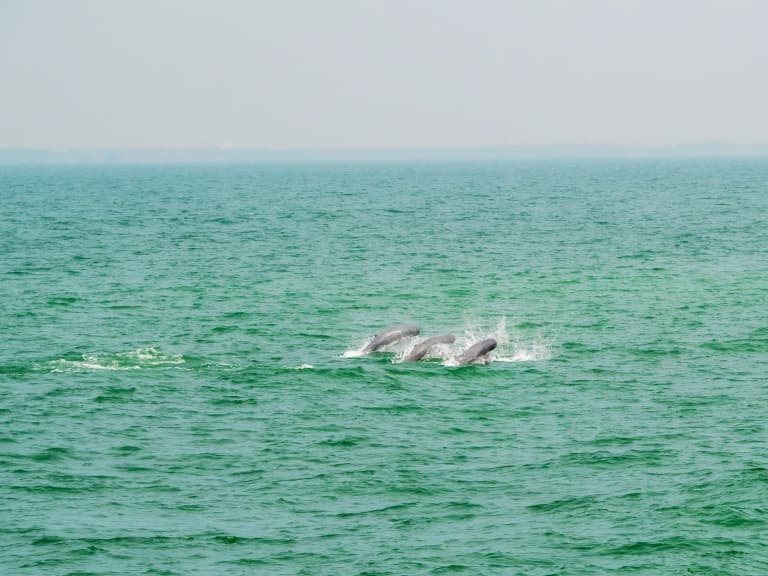Irrawaddy Dolphin Profile
Irrawaddy dolphins (Orcaella brevirostris) are a species of oceanic dolphins. These aquatic mammals live in small populations throughout parts of southeast Asia where salt water and freshwater mix.
Irrawaddy dolphins have rounded heads with short snub noses, unlike many other dolphins.

Irrawaddy Dolphin Facts Overview
| Habitat: | Ocean coasts, riverbeds, & estuaries |
| Location: | Bangladesh, India, Cambodia, Indonesia, the Philippines, Myanmar, & Thailand |
| Lifespan: | About 30 years |
| Size: | 2.3 m (about 7.5 ft) |
| Weight: | 90 to 200 kg (about 200 to 440 lbs) |
| Appearance: | Rounded bodies with tapered tails, broad & rounded heads, & smooth grey & white skin |
| Diet: | Fish, cephalopods, & crustaceans |
| Predators: | Sharks, & humans |
| Top Speed: | 20-25 kph (12-16mph) |
| No. of Species: |
1 |
| Conservation Status: |
Endangered |
While Irrawaddy dolphins look a little like a baby beluga whale, they are not closely related.
Their unique habitat needs limit where they can survive, and these small populations frequently come into contact with humans. They have a great cultural significance to communities in southeast Asia as a result.
Irrawaddy dolphins live in coastal areas in South and Southeast Asia, and in a small number of isolated freshwater bodies, including three main rivers: the Mekong (Cambodia, Laos), the Ayeyarwady (Myanmar), and the Mahakam (Borneo) river. They also live in two lakes: Chilka Lake in India, and Songkhla Lake in Thailand.
They inhabit a 118-mile stretch of the Mekong river between Cambodia and Laos and are extremely rare, with an estimated 85 dolphins on the verge of extinction.
Irrawaddy dolphins are endangered due to pollutants in the water, urbanisation close to their coastal homes, fishing reducing their food source and entanglement in nets and climate change.
Interesting Irrawaddy Dolphin Facts
1. They are mammals and breathe air
At first glance, Irrawaddy dolphins appear to be a type of fish. However, like all dolphins and whales, they are mammals. Irrawaddy dolphins do not have gills and must breathe air from above the surface of the water to survive.

2. They have unusual habitats
Bodies of water have different salinities, or concentrations of salt. Irrawaddy dolphins are euryhaline, which means that they can survive in a wide range of salinities. They live in areas where low-saline freshwater meets high-saline ocean water. As ocean tides, currents, and other forces mix the waters together, the Irrawaddy dolphin’s body adjusts to the changing salinities.
3. Irrawaddy dolphins are known for their short noses
Part of their scientific name, brevirostris, means “short-beaked.”

4. They are 1 of 2 species in their genus
The Australian snubfin dolphin (Orcaella heinsohni) is the other.1 They were recognized as separate species in 2005. 2
5. Their rounded heads have earned them a special name
Irrawaddy dolphins are known as โลมาหัวบาตร (loma hua bat, or “alms-bowl dolphin”) in Thai. The name refers to their head shape, which resembles a bowl used in religious ceremonies. 3
6. Irrawaddy dolphins are related to “killer whales”
Next to the Australian snubfin dolphin, the Irrawaddy dolphin’s closest relatives are orcas, which are sometimes known as “killer whales.” Both are oceanic dolphins and members of the Delphinidae family.
7. They can herd fish by squirting water
Irrawaddy dolphins can squirt water from their mouths over a distance of 1.5 meters (about 5 feet). They use this ability to force fish into smaller areas, where they are easier to catch. 4
8. Irrawaddy dolphins can spyhop
Some whales and dolphins, including the Irrawaddy dolphin, engage in a behaviour called spyhopping. This is when the animal pokes their head vertically out of the water to survey their surroundings for predators and prey. 5
9. They prefer small groups
Irrawaddy dolphins are usually seen in groups of 2 to 5 individuals, although they are sometimes spotted in groups as large as 15. 6

10. Staying in groups keep them safe
Irrawaddy dolphins are vulnerable to threats from sharks. By staying in groups, they become more difficult to hunt and have better chances of survival.
11. Groups also help them hunt
The dolphins can form a circle around prey such as squid and crabs, preventing them from getting away.
12. Irrawaddy dolphins can remain underwater a long time
They can stay submerged for up to 12 minutes without needing to return to the surface to breathe.
13. They help people fish
Irrawaddy dolphins have developed mutualistic relationships with humans in which both the dolphins and the people benefit. The dolphins are known to chase fish into nets for humans. In return, the dolphins are rewarded with a portion of the catch.
14. Irrawaddy dolphins are bothered by noise
These sensitive dolphins are disturbed by noise pollution from boats and other sources. The noise causes them to dive deeper and stay further from populated areas.
15. They are important in Cambodia and Laotian culture
Irrawaddy dolphins are sometimes believed by Cambodia and Laotian people to be the reincarnations of ancestors. Some people even claim that dolphins have saved drowning villagers and protected people from attacks by crocodiles.
16. They are considered sacred
Khmer and Vietnamese fishers have regarded Irrawaddy dolphins and Australian snubfin dolphins as sacred. If the dolphins are caught in fishing nets, the fishers will release the dolphin from the rest of the catch.
17. Irrawaddy dolphins have become popular tourist attractions
Because Irrawaddy dolphins have little natural fear of humans, they will frequently approach and interact with people. Both wild and captive populations of Irrawaddy dolphins have become tourist attractions. 7
18. Special zones have been created to protect them
Local governments have established areas to protect Irrawaddy dolphin populations. In these areas, human activity is limited, and the dolphins are kept safe from harm. These efforts are helping to increase the populations of this threatened species. 8
Irrawaddy Dolphin Fact-File Summary
Scientific Classification
| Kingdom: | Animalia |
| Phylum: | Chordata |
| Class: | Mammalia |
| Order: | Artiodactyla |
| Infraorder: | Cetacea |
| Family: | Delphinidae |
| Genus: |
Orcaella |
| Species: |
Orcaella brevirostris |
Fact Sources & References
- © Roland Seitre photo credit via WWF.
- United Nations Environment Programme. Review of Small Cetaceans: Distribution, Behaviour, Migration and Threats. Regional Seas Reports and Studies No. 177. Accessed January 22, 2022.
- The Society for Marine Mammology. Orcaella brevirostris. Accessed January 23, 2022.
- WWF. Briefing: Irrawaddy River Dolphins. Accessed January 22, 2022.
- Stacey PJ, Leatherwood S. The Irrawaddy dolphin, Orcaella brevirostris: a summary of current knowledge and recommendations for conservation action. Asian Marine Biol. 1997;14:195-214.
- United Nations Environment Programme. FAO Species Identification Guide. Accessed January 23, 2022.
- Sinhah RK. The Irrawaddy dolphins Orcaella brevirostris of Chilika Lagoon, India. J Bombay Nat His Soc. 2004;101(2):244-251. Archived April 10, 2009. Accessed January 22, 2022.
- Wildlife Conservation Society (2006, June 23). Site of Human-Dolphin Partnership Becomes Protected Area. ScienceDaily. Accessed January 22, 2022.
